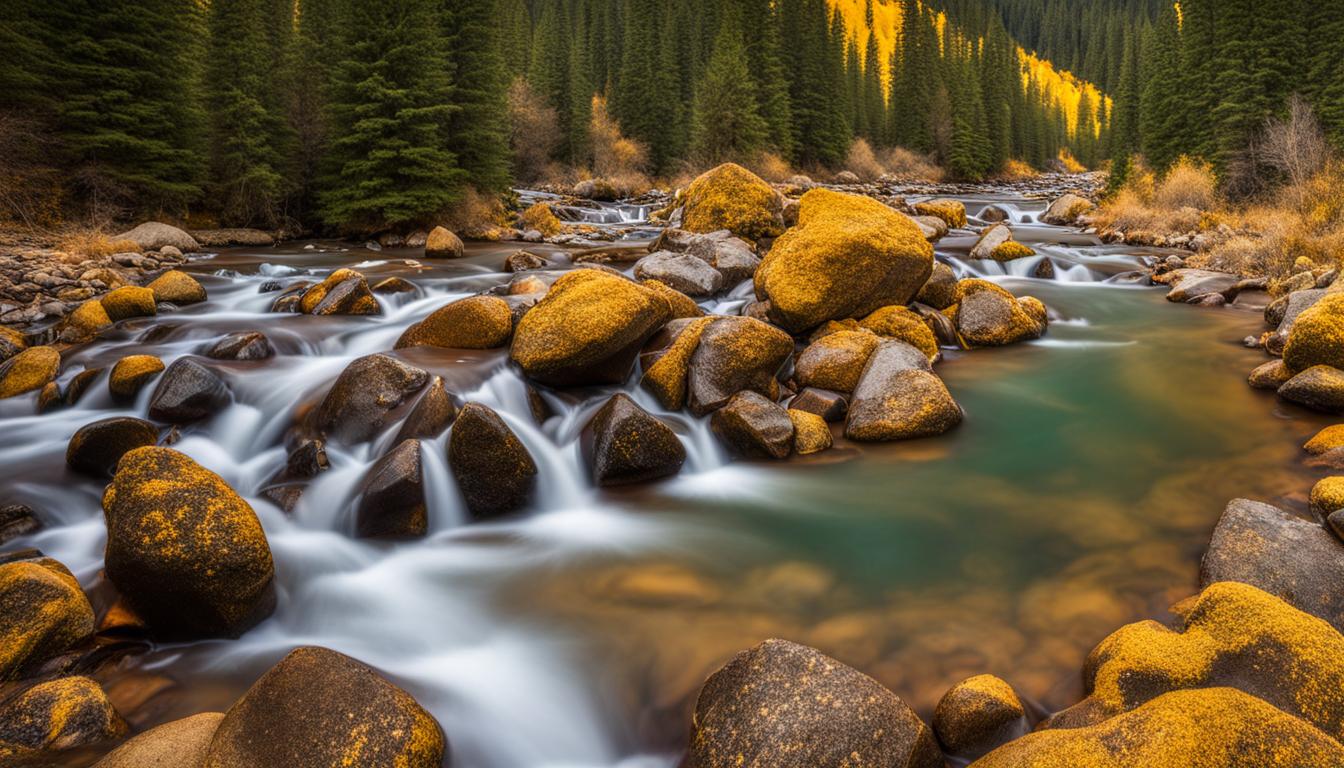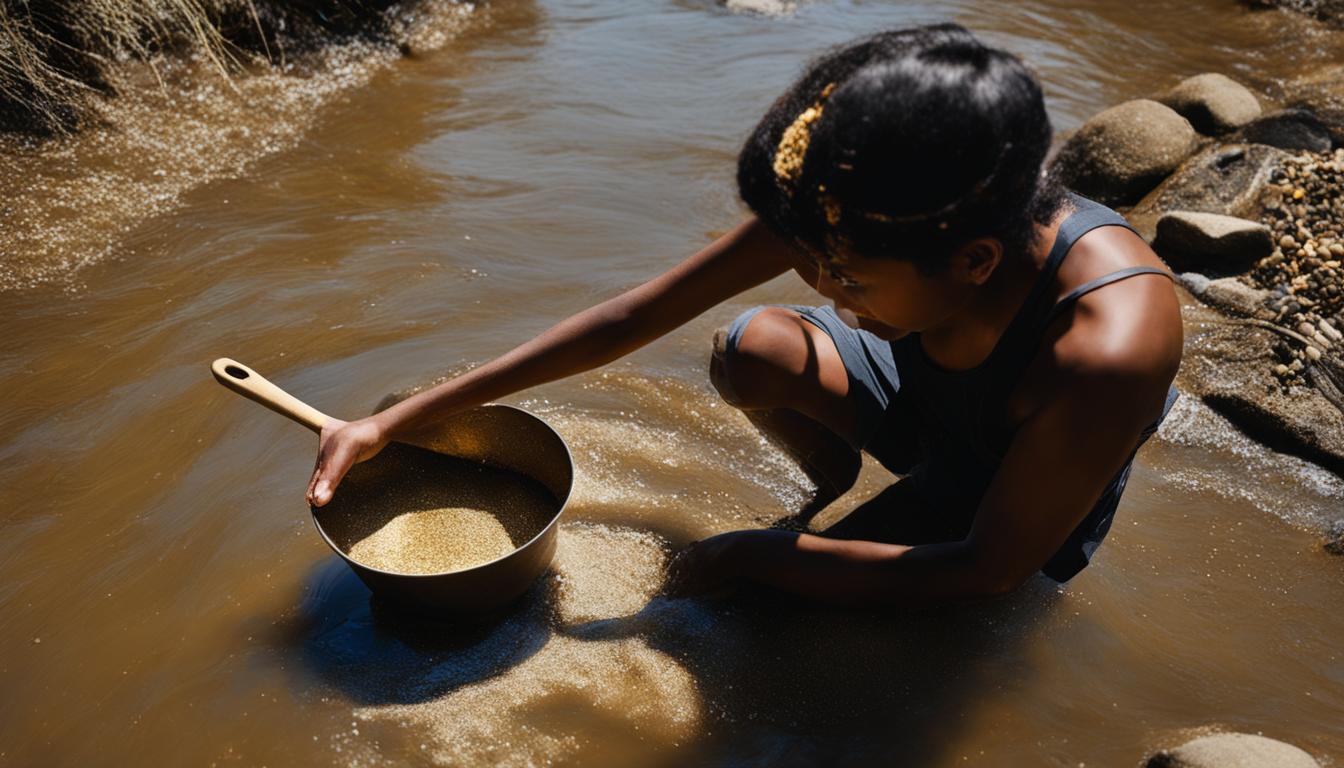Welcome to our comprehensive guide on finding gold. If you’ve ever wondered where to find this precious metal, you’ve come to the right place. In this article, we will explore various locations and spots where you can discover gold. Whether you’re interested in gold mining, searching for gold nuggets, or trying your hand at gold panning, we’ve got you covered. Let’s dive in and uncover the secrets to finding gold!
From well-known gold mining locations to popular gold panning spots, there are numerous opportunities to strike gold. Knowing where to look is crucial, and that’s exactly what we’ll be discussing in the upcoming sections. In the first section, we’ll focus on gold mining locations and highlight some of the top spots to start your search.
Exploring Gold Prospecting Sites
When it comes to gold prospecting, knowing where to search is crucial. In this section, we will uncover the secrets of finding gold nuggets and identifying promising gold deposits. With the right techniques, equipment, and strategies, you can increase your chances of striking gold.
How to Find Gold Nuggets
Finding gold nuggets requires a combination of skill, patience, and the right tools. Here are some essential tips to help you on your quest:
- Research Potential Locations: Start by studying geology maps and historical mining records. Look for areas with a history of gold discoveries and high gold concentrations.
- Use Metal Detectors: Metal detectors are invaluable tools for locating gold nuggets. Choose a detector specifically designed for gold prospecting, as they offer superior sensitivity to small gold particles.
- Search in Gold-Bearing Areas: Concentrate your efforts in known gold-bearing areas such as rivers, streams, and desert washes. Pay attention to areas where gold has been found before.
- Follow the Signs: Look for indicators that suggest the presence of gold, such as quartz veins, iron staining, and other mineralization patterns. These signs can lead you to gold-rich pockets.
- Persist and Be Patient: Remember that gold prospecting takes time and dedication. Don’t get discouraged if you don’t strike gold right away. Keep exploring, honing your skills, and adjusting your techniques.
Identifying Promising Gold Deposits
Understanding the characteristics of promising gold deposits can greatly improve your prospecting success. Here are key factors to consider:
- Geological Context: Study the geological setting of an area to identify favorable conditions for gold mineralization. Look for areas with known orogenic, placer, or epithermal deposits.
- Natural Traps: Focus your search on natural traps, such as bedrock cracks, crevices, and depressions, where gold can accumulate over time.
- Explore Adjacent Areas: Once you discover a gold deposit, explore the surrounding regions. Gold often occurs in clusters, so adjacent areas may hold additional riches.
- Consult Experts: Seek advice from experienced miners, geologists, or local prospecting clubs. Their insights and knowledge can provide valuable guidance for identifying potential gold deposits.
By combining these techniques and strategies, you can enhance your ability to find gold nuggets and discover promising gold deposits.

A Sample Gold Prospecting Sites Table
| Gold Prospecting Site | Location | Gold Potential |
|---|---|---|
| Yukon River | Yukon, Canada | High |
| Victorian Goldfields | Victoria, Australia | Moderate |
| Cripple Creek | Colorado, United States | High |
| Klondike Goldfields | Yukon, Canada | High |
| Witwatersrand Basin | Gauteng, South Africa | High |
This table showcases some renowned gold prospecting sites around the world with their location and an indication of their gold potential. Use it as a starting point for planning your next gold hunting adventure.
Unearthing Gold-Bearing Areas
In the quest for gold, understanding the geology and identifying gold-bearing areas is essential. This section will provide valuable insights into uncovering these gold-rich zones through a combination of scientific knowledge, exploration techniques, and geological processes.
1. Studying Geology
Geological knowledge plays a crucial role in the search for gold-bearing areas. By studying the formation and structure of rocks, geologists can identify potential gold deposits. Some geological features to consider include:
- Presence of quartz veins and mineralized zones
- Folding and faulting patterns
- Precious metal associations
- Types of rocks that host gold mineralization
2. Understanding Mineralization Processes
Exploring gold-bearing areas also requires a deep understanding of mineralization processes. Gold can be associated with various types of mineral deposits, including:
| Mineralization Types | Description |
|---|---|
| Placer Deposits | Gold particles transported and deposited by water |
| Vein Deposits | Gold-bearing mineral veins formed through hydrothermal activity |
| Skarn Deposits | Gold-rich minerals formed in contact zones between igneous and carbonate rocks |
| Porphyry Deposits | Large, low-grade gold-copper deposits associated with igneous intrusions |
| Epithermal Deposits | Hot, low-pressure systems that create gold deposits near the Earth’s surface |
Note: The table provides a brief overview of different mineralization types and their characteristics related to gold deposits.
3. Exploration Methods
Effective exploration methods are crucial for locating gold-bearing areas. Geophysical surveys, geochemical sampling, and remote sensing techniques are commonly used to narrow down potential areas for further investigation. Some exploration methods include:
- Geophysical surveys using magnetic and electromagnetic techniques
- Geochemical sampling of soil, rock, and stream sediments
- Aerial surveys using remote sensing technologies
- Exploratory drilling and testing
Combining geological knowledge, understanding mineralization processes, and utilizing exploration methods will increase the chances of discovering gold-bearing areas. Remember, patience, persistence, and attention to detail are crucial in this endeavor.
Best Places to Find Gold
If you’re eager to discover gold, you’ll want to know the best places to start your search. Below, we’ve compiled a list of top locations where you can find this precious metal. From rivers and creeks to old mining areas, these spots hold the promise of gold waiting to be discovered.
Rivers and Creeks
One of the most fruitful places to find gold is in rivers and creeks. Gold deposits are often carried downstream by erosive forces, settling in the gravels and bedrock of these water bodies. Look for areas where concentration and accumulation of gold particles are likely, such as inside bends, behind large boulders, or in the deep pockets formed by eddies.
Old Mining Areas
Exploring old mining areas can be a rewarding adventure. These locations, once bustling with gold miners, still hold the potential for finding gold today. Seek out areas where historical accounts or records indicate significant gold production. Search for tailings piles, abandoned mines, and tunnels that could offer clues to unexplored riches.
National Parks and Public Lands
Many national parks and public lands provide opportunities for recreational gold prospecting. These areas are often open to the public and allow individuals to search for gold using non-motorized equipment. Research the regulations and permits required for each specific location before embarking on your gold-hunting expedition.
Desert Drywashing
Although gold is commonly associated with rivers and creeks, it can also be found in arid desert regions. Desert drywashing involves using a drywasher, a portable device that uses air and vibration to separate gold from other sediments. Explore dry washes and desert washes to uncover hidden gold deposits in these unique landscapes.
Remember, when searching for gold, always research the local regulations, obtain any necessary permits, and respect the environment. Happy hunting!

Conclusion
In conclusion, this comprehensive guide has unveiled the rich spots where gold can be found. Whether you’re interested in gold mining, panning for gold, or exploring gold-bearing areas, understanding where to find gold is the key to success.
By utilizing the information provided in this article, you can kick-start your gold hunting adventures and unearth the treasures that lie within the earth’s surface. Remember to approach your search armed with the right knowledge, equipment, and techniques to maximize your chances of finding gold.
Exploring gold prospecting sites, unearthing gold-bearing areas, and visiting the best places known for gold deposits are all essential steps in your journey to strike gold. With dedication, patience, and a bit of luck, you may soon find yourself holding valuable gold nuggets in your hands.
FAQ
Where can I find gold?
Gold can be found in various locations and spots, such as gold mining locations and gold panning spots. These include rivers, creeks, old mining areas, and even certain geological formations. By exploring these areas, you increase your chances of finding gold.
How do I find gold nuggets?
To find gold nuggets, you need to engage in gold prospecting. This involves using specialized equipment like metal detectors and gold pans to search for gold in rivers, streams, and other gold-rich areas. Understanding the geological indicators and learning from experienced prospectors can also increase your chances of finding gold nuggets.
What are gold deposits?
Gold deposits refer to areas where gold is naturally concentrated and accumulated. These can range from alluvial deposits, where gold is transported and deposited by water, to vein deposits, where gold is found within mineralized quartz veins. Exploring these deposits requires knowledge of geology and mineralization processes.
How can I explore gold-bearing areas?
Exploring gold-bearing areas involves studying geological maps, understanding the local geology, and identifying areas with favorable mineralization processes. This can be done through geological surveys, research, and consultation with experts. Additionally, conducting fieldwork and testing different methods of exploration can help in uncovering gold-bearing areas.
What are the best places to find gold?
Some of the best places to find gold include rivers, creeks, and streams. These water bodies often carry gold particles and nuggets from upstream sources. Additionally, exploring old mining areas or areas with historical gold production can also lead to successful gold discoveries. Remember to obtain any necessary permits or permissions before prospecting.




